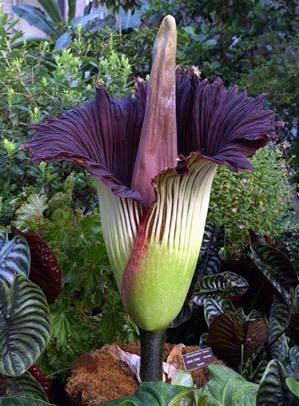

A blooming "corpse flower" can be ten feet tall and smells like rotting human flesh. The flower, originally from of West Sumatra, Indonesia, bloomed last month at the Houston Museum of Natural Science.
Thousands of people visited the Houston Museum of Natural Science last month to observe the slow birth and quick death of Lois, the pet name for a corpse flower from West Sumatra, Indonesia.
When in bloom, the endangered flowers can grow to be five feet wide and ten feet tall; only 28 have successfully bloomed in the United States. Over several weeks, a corpse flower will double its size then stop growing completely, a sign a bloom may be imminent. As the flower opens an unbearable smell is released, something like the “combination of cooking cabbage and the stench of a dead rat in the wall,” reads one account. Others say the smell most resembles rotting human flesh. After just two days, the bloom is over.
The corpse flower is something of an aberration; for the most part humans use flowers to cover up the stench of rotting flesh. The history of exactly how this happened is actually spotty. No one knows for certain when the practice began, but some researchers trace it to a cave in the remote Zagros Mountains of northern Iraq.
Shanidar cave lies at the base of a steep rock pile on a scrub-covered hillside. In the late 1950s, a team of archaeologists from Columbia University excavated the cave, discovering a set of nine Neanderthal skeletons, the first ever to be found in Iraq. They were 60-80,000 years old. Soil samples from the cave included pollen grains and bits of vegetable matter that when analyzed were revealed to contain 28 different plant species. These findings were used as evidence to support the hypothesis that at least several of these bodies were ritualistically buried on a bed of woody branches and flowers sometime during the months of May, June or July, when the flowers were in full bloom.
Among the flowers found were St. Barnaby’s thistle, a grayish-green plant with bright yellow flowers and long sharp spines and yarrow, (also nicknamed nosebleed plant, soldier’s woundwort or devil’s nettle), a plant with feather-shaped leaves and yellow, red or pink flower bunches that during antiquity were used to staunch the flow of blood from wounds. However, not everyone believes the flower story; some researchers think ancient rodents burrowed into the cave and stored the seeds and flowers. Either way, at a point in history that is not known precisely, flowers began to appear regularly at funerals, in part to add color and life to an otherwise somber affair and in part to mask odor.
One of the most famous cases of flowers masking the stench of death involved President Andrew Jackson, who survived a gunshot wound that shattered a shoulder and another that shattered two ribs then lodged itself beside his heart. He finally died at age 78, from what was likely heart failure. His body was not embalmed and by the day of the funeral it was in such horrendous shape that the undertaker, a man named Lazarus C. Shepard, literally buried the coffin in fragrant flowers to cover up the odor.
In the early 20th century, the practice of hosting funerals in flower gardens became common. Some funeral home directors brought the garden inside, conducting services in solariums, with waterfalls, live plants, flowers and even birds. As far as anyone knows, a blooming corpse flower has never been present at a funeral.
The corpse flower was introduced to the world by popular BBC nature show host Sir David Attenborough, who in 1994 trekked into the jungles of West Sumatra with a Californian doctor whose life goal was to see the flower in bloom in the wild. The group hired a team of trackers to canvass the forest. Eventually, they found a corpse flower on the verge of blooming.
“I couldn’t smell anything at first, but as we filmed it I became aware that the flower was starting to produce a bad smell, which came in waves,” said Attenborough. “Nobody knew how it was fertilized, so we cut a tiny little hole in the side and stuck the camera in and filmed some sweat bees. So these were the pollinators! It was rather entertaining to find out that the biggest of all flowers – or inflorescences, to be technical – was fertilised by the smallest of insects.”
The most famous coroner on earth may well be Dr. Thomas Tsunetomi Noguchi, who was…
The day after Halloween, and the day after that, is Day of the Dead, and…
Following on his recent posts regarding deaths by extreme heat, Justin Nobel shares his thoughts…
Few parts of the country have been spared from July's soaring temperatures. In fact, July…
Deep inside a South African cave called Rising Star, scientists have made an incredible discovery—a…
Last week, in Nakano City, Japan, an evacuation center was opened in the gymnasium of…